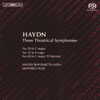Haydn Symphonies Nos 12, 50 & 60
Huss finds the fun and fantasy in Haydn’s endlessly enjoyable symphonies
View record and artist detailsRecord and Artist Details
Composer or Director: Joseph Haydn
Genre:
Orchestral
Label: BIS
Magazine Review Date: 3/2011
Media Format: Hybrid SACD
Media Runtime: 0
Mastering:
Stereo
DDD
Catalogue Number: BIS-SACD1815

Tracks:
| Composition | Artist Credit |
|---|---|
| Symphony No. 12 |
Joseph Haydn, Composer
Joseph Haydn, Composer Manfred Huss, Conductor Vienna Haydn Sinfonietta |
| Symphony No. 50 |
Joseph Haydn, Composer
Joseph Haydn, Composer Manfred Huss, Conductor Vienna Haydn Sinfonietta |
| Symphony No. 60, 'Il distratto' |
Joseph Haydn, Composer
Joseph Haydn, Composer Manfred Huss, Conductor Vienna Haydn Sinfonietta |
Author: David Threasher
The best-known of this group of symphonies is No 60, composed in 1774 “per la Commedia intitolata il Distratto”. The music’s “distractions” – trademarks of Haydn’s style – include fanfare interruptions, motifs that mither around a single chord before being nudged back into reality, rapid changes of mood and, most famously, the orchestra quite forgetting where it is in the finale, retuning, and then carrying on. The six-movement work is assuredly one of Haydn’s oddest; Huss and the HSW major more on its nervous energy than the whimsicality Harnoncourt underlines with the Concentus Musicus (WCJ, 12/90R).
Symphony No 50 started life in 1773 as the prelude to a marionette opera, and found its symphonic form when Haydn added a minuet and finale. No 12 comes from a full decade earlier and was presumably conceived as the opening and incidental music to Acide, in which form it has already been recorded by these musicians (8/09). Galant gestures take primacy over sustained motivic argument but it nevertheless contains shades of nascent Sturm und Drang and provides a piquant E major cushion between the two more thrusting C major works. The coupling is unique, the programming considered and the project a delightful success.
Discover the world's largest classical music catalogue with Presto Music.

Gramophone Digital Club
- Digital Edition
- Digital Archive
- Reviews Database
- Full website access
From £8.75 / month
Subscribe
Gramophone Full Club
- Print Edition
- Digital Edition
- Digital Archive
- Reviews Database
- Full website access
From £11.00 / month
Subscribe
If you are a library, university or other organisation that would be interested in an institutional subscription to Gramophone please click here for further information.




